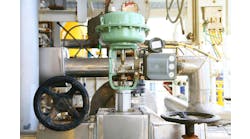Many editorials and columns talk about what's going on in their publications. However, as I was proofreading this March 2011 issue, I started tripping over some unexpected connections between many of what initially seemed to be distinct stories. Yes, I know they should have common threads because they're all about various aspects of process control and automation, but I think these connections ran deeper. It was almost as if the authors and experts in one story were commenting on how to solve problems in other stories. Now, I didn't actually hear voices, but this phenomenon was pretty spooky anyway.
My surreal little trip began with my feature article this month, "Oil Fields Yield Digital Data," which is about how Landmark Software and Services uses its integrated production operations (IPO) software to help Chevron Corp. coordinate numerous data streams from 30 oil, gas and injected water wells coming into its floating, production, storage and offloading (FPSO) vessel at the Agbami oil field off the coast of Nigeria. Now, I'm not bobbing on the waves myself, but I sure can sympathize with the engineers and operators that have to explore and extract oil and gas offshore, gather related production data, keep the whole process running safely and efficiently, and do it in ever deeper and more dangerous water.
Naturally, I was even more concerned when I read Editor-in-Chief Walt Boyes' editorial, "Careful, We Don't Want to Learn from This," in which he lamented on the tragic and apparently endless parade of injuries and deaths caused by persistently inadequate process safety practices and regulations.
However, the sun pierced this gloom when I read Senior Technical Editor Dan Hebert's cover story, "User-Centered Design at Work." He described how Conoco Phillips and others employ UCD to improve HMIs in control rooms, which is one of the main problems Boyes raised in his editorial. You can almost hear one story advising the other. "How can I fix these confusing displays and alarm cascades?" "Well, you could redesign your displays in accordance with the Abnormal Situation Management (ASM) Consortium's guidelines."
Meanwhile, in "Eliminating the Control Valve," veteran contributor Dick Caro reported on his recent survey, which revealed that most process control engineers and technicians are reluctant to replace energy-gobbling valves with variable-speed drives (VFDs) mainly because they know so little about VFD technology. Pretty sad.
However, right after that, and almost in direct counterpoint to the lethargic use and understanding of VFDs, three university professors from Algeria—Ahmed Hafaifa, Attia Daoudi and Mouloud Guemana—reported in "SCADA for Surge Control" about their journey toward an innovative approach to using a SCADA network to handle surge control in gas compression systems in pipelines. Pretty cool.
Some of the best news came from Béla Lipták's "Lessons Learned" column, which showed how reversible fuel cells might use hydrogen to store and release electricity from solar sources, and how process control engineers will be needed to help. I was even more encouraged when I read this month's "Control Online" column, which detailed the debut of our company's new www.SustainablePlant.com website. It features oil tanker-sized loads of information on how users can go green and begin to adopt some of the practices that Lipták recommends.
It's easy to see that each of these stories is just a different facet of the same gemstone, and that the apparent give and take between them simply reflects Control's general focus. But I think that becoming aware of their less-obvious connections can lead to a deeper understanding of the process control field than just reading only one of the stories—much like flying over Peru's ancient Nazca lines reveals their true patterns and pictures. So maybe go back and read some more, and then keep listening.





